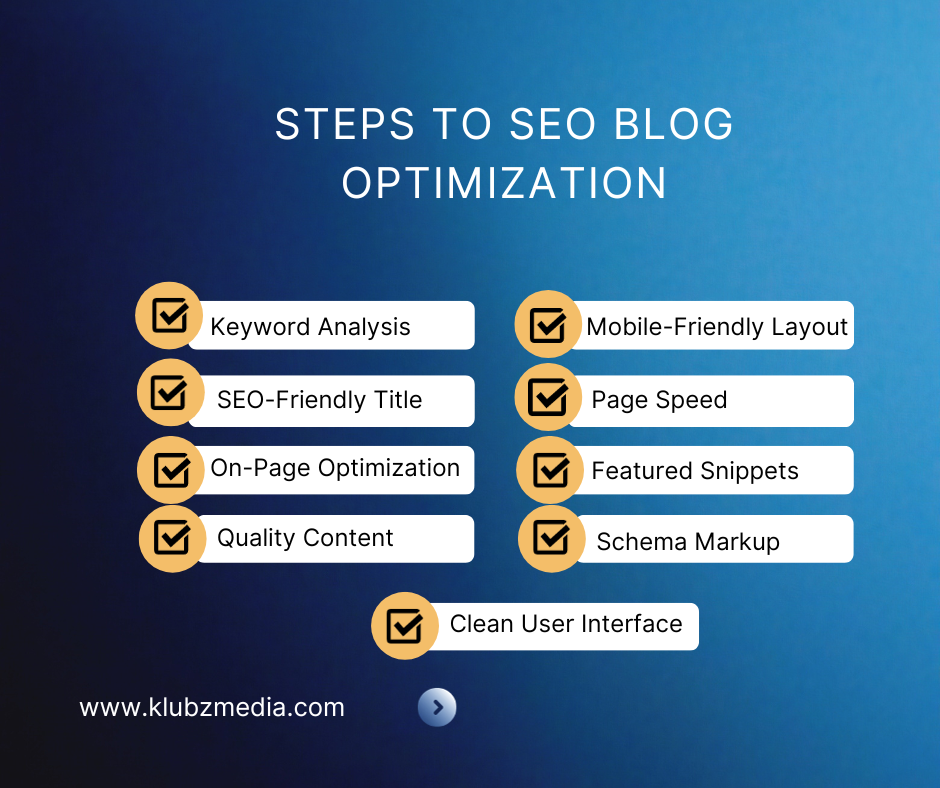SEO blog optimization is the technique of optimizing blog material to increase its visibility and ranking in search engine results. With the help of this guide on understanding and learning SEO, you can take your blog to new heights. Increase your online visibility, and learn the techniques of search engine optimization through the quick and easy steps.
SEO blogs are the most prominent tactic used by content marketing services. If you consider the competition that exists between blog writers in the current time, you will certainly get the importance of learning a technique that can help your blog to get noticed on the internet, bring more visitors, and make it easier to succeed online and that technique is known as SEO blog optimization.
How Does SEO Improve Blogging?
What will be the purpose of writing a blog if nobody reads them? What will be the purpose of publishing a blog if it attracts no traffic? – It’s not worthy spending your hours writing a piece that stays dead on your blog site. Thus, you need SEO to make your blog visible to the traffic. So, people read them, acknowledge them and serves the purpose of spreading knowledge to your targeted client.
- Reaching the Targeted Audience: By using keywords strategically, you can draw in readers who are specifically interested in the topic of your blog.
- Gaining Visibility: SEO optimization raises your blog’s visibility by raising its position in search results.
- Getting Competitive Advantage: In the digital environment, optimizing SEO for blogs gives your blog a competitive advantage.
- Providing Better User Experience: By improving the user experience, SEO optimization makes your blog easier to read.
- Enhancing Credibility: High-ranking content increases your authority and credibility in your niche.
- Achieving Long-Term Success: Content that has been properly optimized can continue to perform well and draw in traffic.
SEO Blog Optimization: Step by Step

Keyword Analysis
The backbone of SEO lies in finding the terms people use to search for content similar to yours and it is made easier with the aid of keyword research.
- Look for relevant keywords.
- In order to create a list of potential keywords, use keyword research tools(for example, Google Keyword Planner, Semrush, Ahrefs and so on)
- For precise targeting, pay attention to long-tail keywords (phrases with three to four words).
- Think thoroughly about search trends and user intent in your field.
- Look at keyword competition for inspiration.
SEO-Friendly Title for Blog
After finding your suitable keyword you need to find a title that follows the SEO optimization guideline.
- Include the target keyword: Naturally include your main keyword in the title, preferably at the start. Make sure the title is intriguing and relevant to the blog’s subject matter.
- Keep it brief: To guarantee that your title displays properly in search results, aim for a title length of 60 to 70 characters. Give a concise explanation of the blog’s core subject and goal.
- Involve the reader: Create titles that inspire interest or provide answers to common issues. When applicable, add action verbs or numbers to the title to make it more captivating.
- Skip the clickbait: Make sure your blog’s title correctly describes its content. Avoid titles that are deceptive or sensationalized because they might cause high bounce rates and low ranks.
On-Page Optimization
By carefully selecting keywords and enhancing meta data, on-page optimization entails making individual blog articles more search engine-friendly. Three major ideas that fall under on-page optimization include- optimizing meta elements, doing proper keyword placement in headings and subheadings, and lastly, using user-friendly URLs.
- Optimizing Meta Elements: Firstly enhance the meta components by adding the desired term to the meta description and title.
- Doing Proper Keyword Placement in Headings and Subheadings: For SEO optimization, headings and subheadings must be used properly. Include your primary keyword in the H1 and secondary keywords in subheadings (H2, H3, etc.).
- Using User-friendly URLs: For SEO blog optimization, using user-friendly URLs is essential. These brief, descriptive URLs increase user experience and raise search engine rankings. Your content will be easier to locate and distribute if you use suitable keywords and omit irrelevant symbols.
Quality Content
High-quality content is the foundation of effective SEO optimization.
- Write in-depth, thoroughly researched, and unique content.
- Your target audience’s demands and inquiries should be addressed.
- Make your wording precise and simple.
Mobile-Friendly Layout
With the increasing use of mobile devices, it is essential for SEO that your blog is mobile-friendly.
- Check how your blog works and looks on various mobile devices.
- On smaller screens, make sure the text and photos are readable.
- Avoid intrusive pop-ups and other items that interfere with mobile usage
Optimizing Page Speed
Optimizing page performance is essential because it affects both user experience and SEO rankings.
- Utilize dependable hosting to reduce server response times.
- For frequently accessed resources, make use of browser caching.
“Featured Snippets” Strategy
You should try to maximize your chances of a featured snippet. The majority of featured snippets contain one of four types of data.
- A sentence or section of an article that immediately responds to the query’s question.
- A list with numbers or bullets designating the material as an answer to the question.
- A data table with the necessary information to respond to the query.
- A video that explores and responds to the query
Build Links from Within and Outside Your Site
Navigating links both internally and externally improves a site’s overall SEO structure.
- Internal Linking
- Link to appropriate internal pages to facilitate navigation.
- Use anchor text that is evocative.
- For your blog, use a hierarchical framework.
- External Linking
- Link externally to reliable sources to bolster your content.
- Check to see if external links are trustworthy and relevant.
Schema Markup
Schema markup, sometimes referred to as structured data markup, is a language of tags (HTML code) that you can use to add to the content of your website. By giving search engines structured data, schema markup improves the visibility of your blog in search results.
- Implement schema markup for articles, reviews, and other pertinent content kinds to choose the appropriate schema types.
- Use structured data when it’s appropriate for reviews of products, recipes, or events.
- To generate markup code, use Google’s Structured Data Markup Helper.
- Utilizing Google’s Structured Data Testing Tool, verify schema implementation.
Focus on Keeping a Clean User Interface
In addition to keeping visitors interested, a good user experience helps a website rank better in search engines.
- Simple Navigation:
- Your blog should be organized with a simple navigation system.
- Create a search engine that is easy to use.
- Formatting and Readability:
- Use readable typefaces in the correct sizes.
- Create sections within the material with distinct headings.
- For easier reading, use numbered lists and bullet points.
Here’s a simple breakdown of what we’ve covered in the blog:
- Keywords: Think of these as the secret codes people use to find stuff online. Find the right ones, and you’re on your way.
- Great Titles: Your blog’s title should be like a trailer for a movie. It should tell people what’s inside and make them want to click.
- Headings and Subheadings: Break up your content with these. They’re like signposts, helping readers and search engines understand your blog better.
- Quality Content: Simple – write awesome stuff that people want to read. Easy, right?
- Mobile-Friendly: More and more people use their phones to browse, so your blog needs to look good on those little screens.
- Speed It Up: Don’t keep your readers waiting. Make sure your blog loads fast.
- Featured Snippets: Ever seen those quick answers on Google? Aim to be one of those! They’re like gold for attracting readers.
- Links: Connect the dots within your blog (internal links) and to other trusted websites (external links). It helps everyone navigate better.
- Schema Markup: Don’t be scared by the term. It’s just a way to make your blog more understandable to search engines.
- User-Friendly: Think about your readers. Keep your blog easy to navigate and read.
Now that you know the steps to making your blogs hopefully appear in the top list of google searches, you might want to polish your understanding of SEO even more. To ensure more proficiency you can seek professional assistance in a simple step ‘ Contact us’.
Final Statement
To conclude, it can be said that learning the technique of SEO blog optimization isn’t a difficult puzzle to solve; rather, it’s your road map to maximizing the potential of your blog in the broad digital surface. You may increase user engagement, increase user exposure, and connect with a targeted audience by following these straightforward steps. So go ahead and put these techniques into practice, then watch as your blog rises to new heights online. Have fun writing!



